Pennsylvania spans the Northeastern, Mid-Atlantic, Appalachian, and Great Lake regions of America. The fifth most populous state in the country has more than just people living in it. There’s also a healthy wildlife population living in one of the heavily-forested states in the country. The state of Pennsylvania hosts different species of native wildlife.
Unfortunately, some of these animal species don’t have thriving populations. Several animals living in Pennsylvania have their population under threat of extinction mainly due to man-caused factors and climate change.
This post lists 10 of the most amazing animals that are endangered and living in Pennsylvania.
1. American Bittern (Botaurus lentiginosus)

The American bittern is endangered because it needs specialized marshes to reproduce.
©iStock.com/Marianne Pfeil
Pennsylvania’s Game and Wildlife Code lists the American bittern as endangered. This giant heron lives in large wetlands where they breed and nest. It’s a big bird, with an enormous wingspan of 50 inches and a 34 inches height. The American bittern’s brown streaked plumage is instantly recognizable. It has black mustache-like cheek marks and black outer wings that are noticeable in flight.
The American bittern is endangered because it needs specialized marshes to reproduce. This is a problem since Pennsylvania’s wetlands have reduced in size by more than 50% within the past two centuries. Sedimentation, eutrophication, chemical contamination, and encroachment threaten marshes. Although this bird species is not threatened in other parts of the country, it is a state-endangered animal in Pennsylvania.
2. Black-Crowned Night Heron (Nycticorax nycticorax)

The black-crowned night heron or black-capped night heron has white feathers on its breast along with greyish-black wings.
©Nycticorax nycticorax/Shutterstock.com
The black-crowned night heron is listed as endangered by Pennsylvania’s Game and Wildlife Code. This medium-sized heron has a short neck and is stocky. The black-crowned night heron is larger than a crow but smaller than a great blue heron. The adults have a black crown and upper back. The wings, rump, and tail are gray, while the breast is light gray.
Black-crowned herons were once abundant in Pennsylvania. In fact, they were probably the most common nesting heron in the state in the late 19th century. This species is currently one of the endangered animals in Pennsylvania due to dwindling habitats. The largest colony left in the state lives on Wade Island and is currently facing threats from erosion and fierce competition with other birds (like great egrets and double-crested cormorants) for nest sites.
3. Bog Turtle (Glyptemys muhlenbergii)
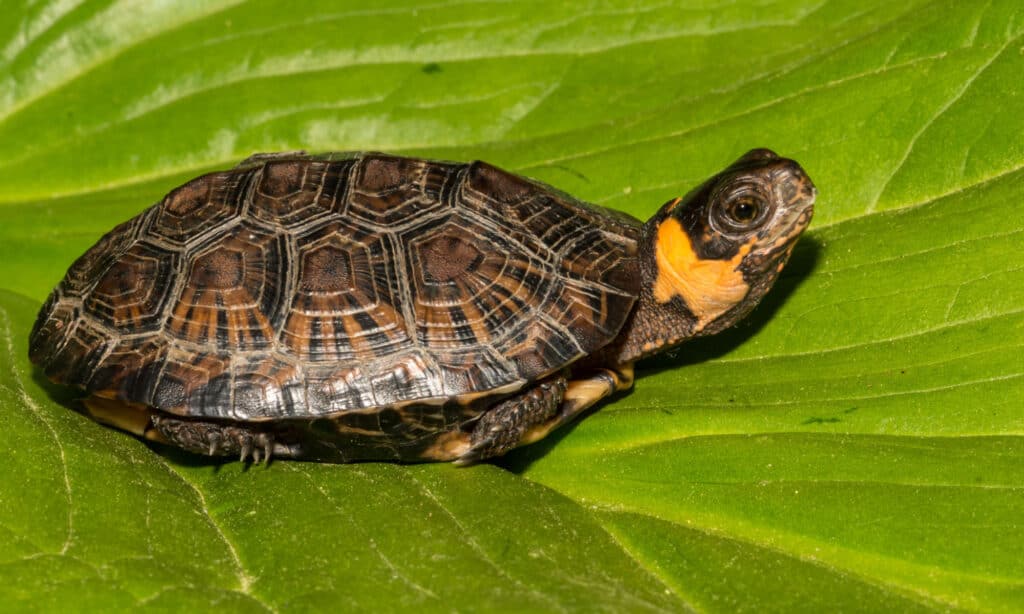
Like all turtles, bog turtles have a long lifespan. They can live up to 50 years, but the average lifespan is about 20-30 years.
©Jay Ondreicka/Shutterstock.com
The bog turtle is among the smallest turtle species in Pennsylvania, with mature ones growing to a maximum length of about four inches. They have yellow-orange splotches on the sides of their neck and head, giving them a unique appearance. The rest of their body (including the shell) is also black.
Like all turtles, bog turtles have a long lifespan. They can live up to 50 years, but the average lifespan is about 20-30 years. Despite this, the bog turtle is still classified as endangered due to the recent massive decline in its population. Experts have blamed habitat loss for this. Bog turtles have specific requirements for their habitats.
They live in wet meadows, low flood plains, and grazed wetlands. The current decline of grazed wetlands is one major reason this species is declining. Habitat loss due to intrusion from invasive plant species is another reason bog turtles are under threat. Fatal encounters with humans, such as accidents while crossing roads are another reason why bog turtles are on this list of endangered animals in Pennsylvania.
4. Black Tern (Childonias niger)
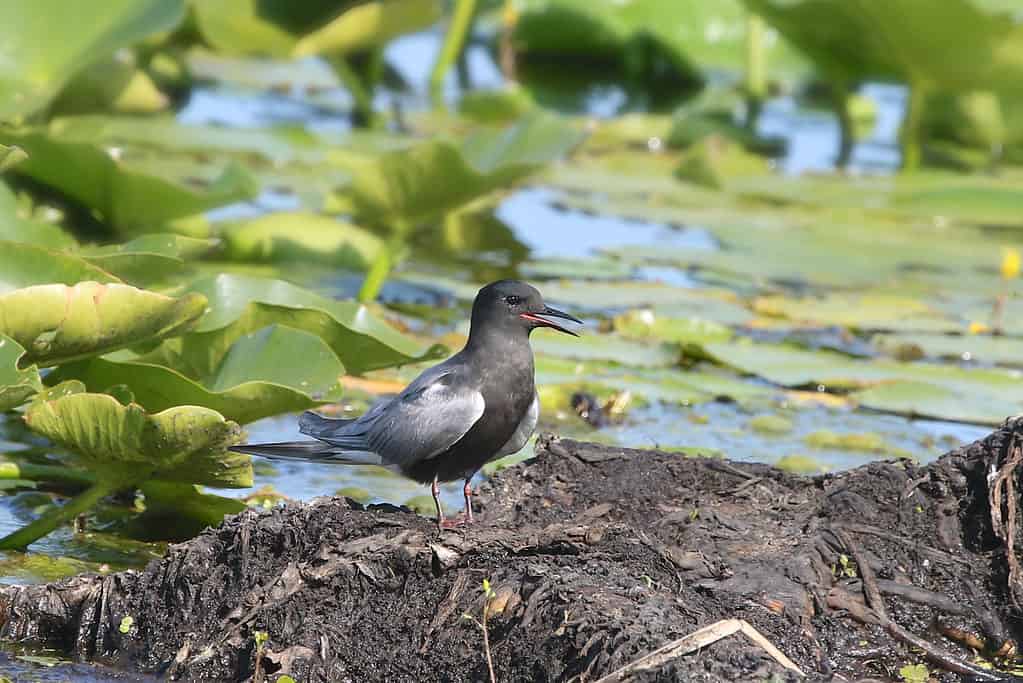
Black terns are considered both nesting and migratory birds in Pennsylvania.
©vagabond54/Shutterstock.com
Terns are long-winged, elegant fliers with a healthy population in other parts of the country but are endangered in Pennsylvania. Black terns are coastal birds, although they breed on interior marshes. The black tern’s flashing underwing linings are noticeable in flight, and they fly like low-flying butterflies.
Black terns are considered both nesting and migratory birds in Pennsylvania. Unfortunately, their population has declined both as migrant birds and in their nesting locations. They originally nested in Crawford County and are now in Erie County’s Presque Isle State Park.
Experts attribute their decline to both man-made and natural calamities. Population losses in North America may be caused by habitat loss and the degradation of breeding grounds. Introduced species, human disturbance, and pollutants may also contribute to this species’ possible future extinction.
5. Common Tern (Sterna hirundo)

The common tern is a beautiful waterbird that flies low and floats like a swallow (a passerine songbird). These birds are noticeably more diminutive than the more common ring-billed gull. They also lack the latter’s signature black bill ring and instead have gray-colored wings, a black cap, and a white throat.
Their length is 12–14 inches, and their wingspan is about 30 inches. Among the tern species in North America, common terns are the most widespread. They used to nest in abundance in Pennsylvania back in the 20th century, and up to 100 nesting pairs were found in one location in the 1930s.
However, successful nesting has not taken place in recent times. At the turn of the 20th century, many bird species were shot for hats, and this includes the common tern. This, along with egg and birds gathering, led to the decline of several bird species.
6. Dickcissel (Spiza americana)
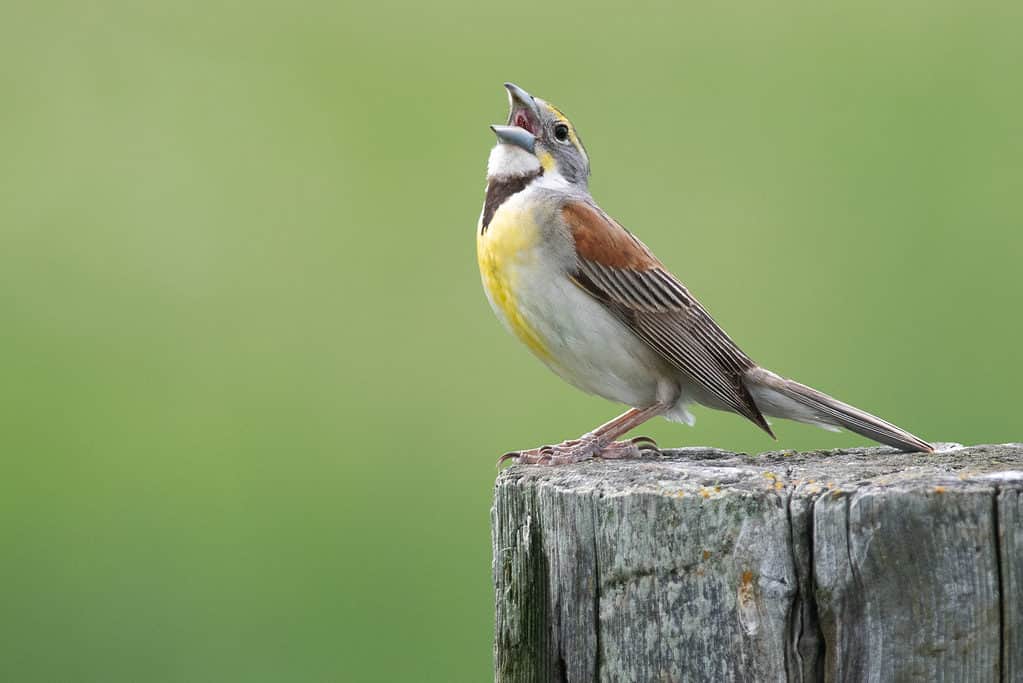
Dickcissels have a grayish-brown back with dark streaks, a light yellow breast, and a white throat with a huge black bib.
©Amanda Guercio/Shutterstock.com
Dickcissels were plentiful in southeastern and southwestern Pennsylvania in the 19th century. They’re medium-sized birds, about six to seven inches tall, and have a wingspan of about nine to 11 inches.
Dickcissels have a grayish-brown back with dark streaks, a light yellow breast, and a white throat with a huge black bib. Dickcissel females and juveniles look a lot like house sparrows. However, they are stockier and often have a hint of yellow in their eye stripe and on their chest.
Changes in land use in Pennsylvania are the major cause of the endangering of dickcissels. The bird species live and nest in grassy fields, which are becoming quite rare in Pennsylvania in recent years due to human development and agricultural activities. While they are endangered in the state, it is important to note that this species has always had a history of erratic nesting behavior in Pennsylvania. Hence, their absence is not entirely surprising.
7. Indiana Bat (Myotis sodalis)
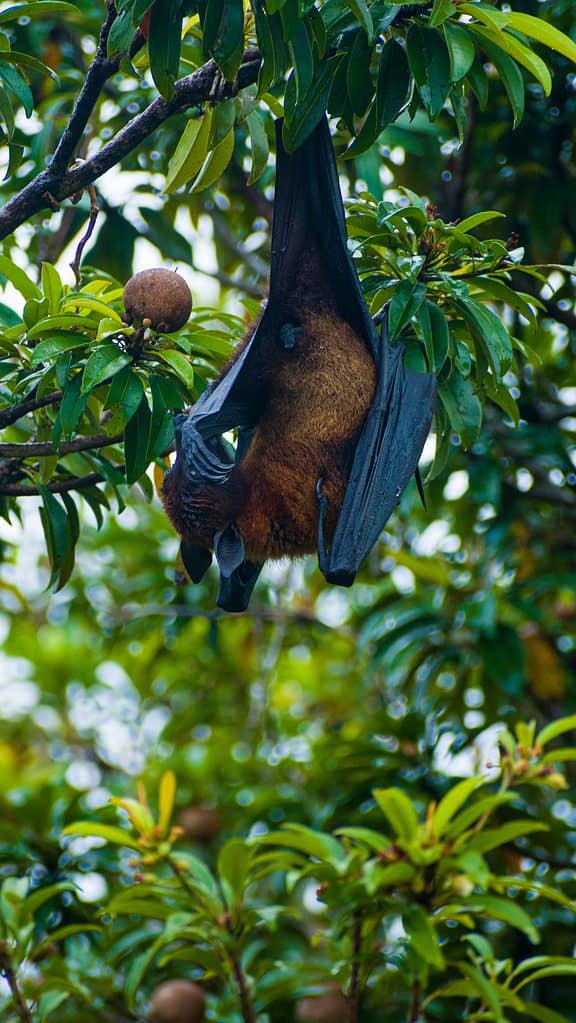
Populations of the Indiana bat have declined throughout its range, and not just in Pennsylvania.
©Arjunsunil/Shutterstock.com
The Indiana bat resembles two other species from the same genus — the common little brown bat and the less common northern long-eared bat. Myotis sodalis has a pinkish face, in contrast to the typical dark coloration of its other relatives. Its pinkish-brown fur is bland, and the membranes of its ears and wings don’t stand out from the fur.
This bird is among the endangered animals in Pennsylvania due to human incursion into hibernation sites (caves) during winter. Low populations of the Indiana bat (Myotis sodalis) are present across much of the Eastern United States, from Oklahoma to Iowa, Wisconsin, Vermont, and South and Northwest Florida. Until recently, just eight natural caverns in Pennsylvania were suitable hibernation locations for this species. Populations of the Indiana bat have declined throughout its range, and not just in Pennsylvania.
8. King Rail (Rallus elegans)
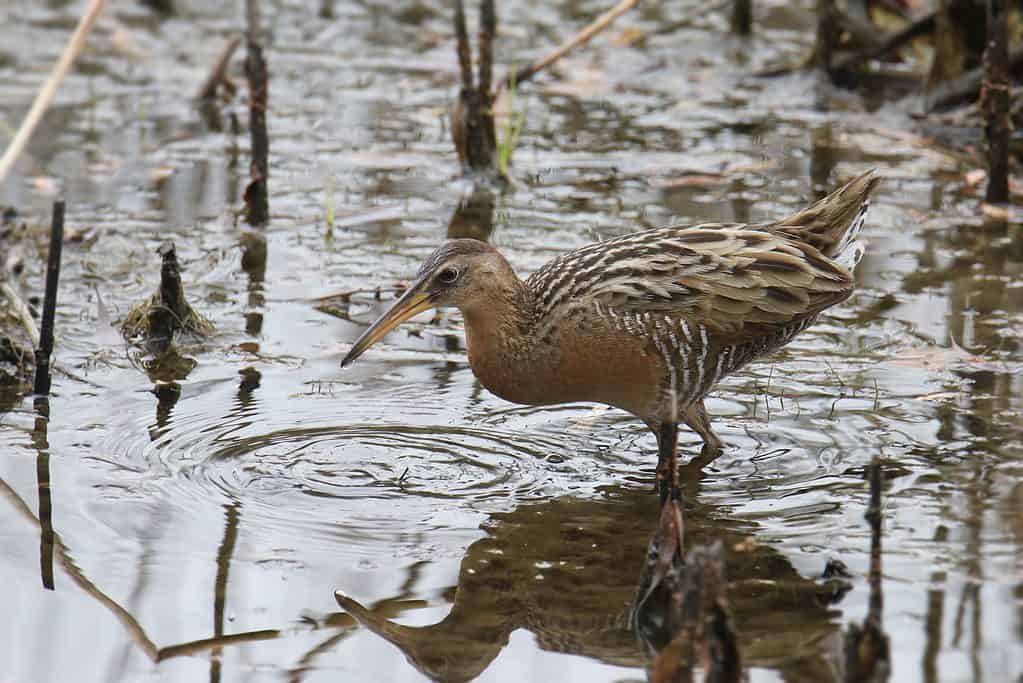
The king rail is significantly larger in comparison to the widespread Virginia rail.
©vagabond54/Shutterstock.com
It has never been common to see a king rail in the state of Pennsylvania. Only a handful of sites around the state are breeding or nesting grounds for this bird. The king rail gets its name from its massive size and brilliant hues. This rusty-colored bird, about the size of a chicken, weighs nearly a pound.
They can grow to a height of up to 15 to 19 inches and a wingspan of 21 to 25 inches. The king rail is significantly larger in comparison to the widespread Virginia rail. The species is characterized by long, (somewhat curved) bills with golden and brown ends.
These birds are elusive. They would rather run than fly to avoid detection. Reductions in marshland habitat quality and quantity are the primary causes of the bird’s decline.
9. Northern Flying Squirrel (Glaucomys sabrinus macrotis)
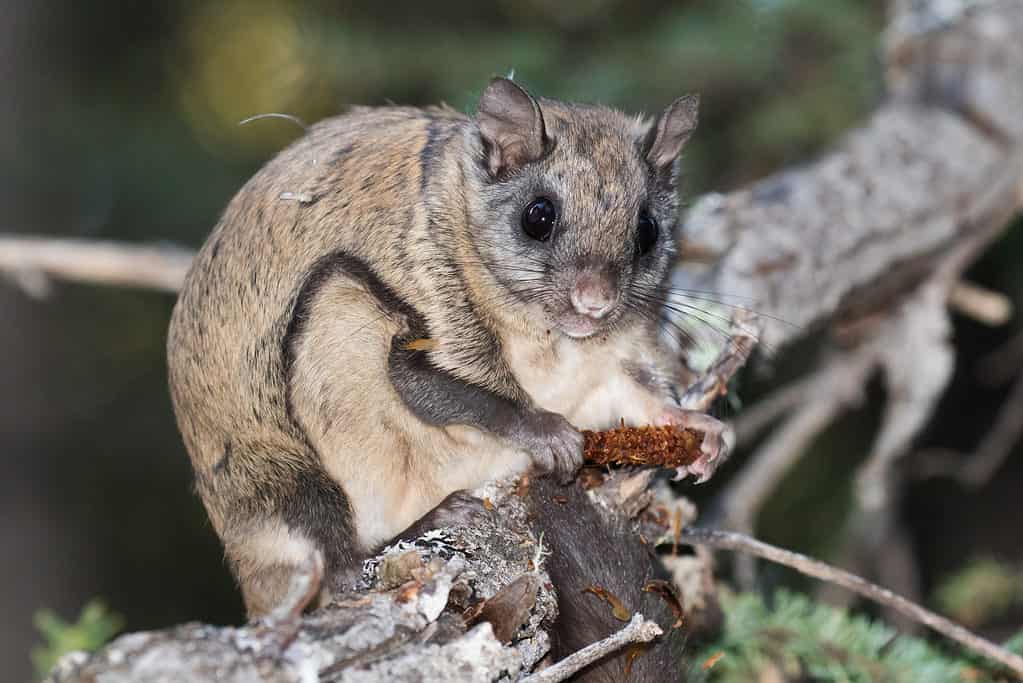
In Pennsylvania, the northern flying squirrel is listed as endangered, and the reason is mainly due to habitat loss.
©Jukka Jantunen/Shutterstock.com
Named after its ability to glide from tree to tree, the northern flying squirrel is one of Pennsylvania’s most interesting species. It has skin flaps between its ankles and wrist with a flattened tail. These features make it possible for the squirrel to glide in the air, and they can cover a distance of up to 65 feet moving this way.
In Pennsylvania, the northern flying squirrel is listed as endangered, and the reason is mainly due to habitat loss. These squirrel species feed mainly on fungi and lichens from trees or found growing on the ground. Their food source is most abundant in old-growth boreal forests with many coniferous trees, moist soil, and woody debris. Unfortunately, the state is losing this older conifer and mixed forests to development. They also face threats from better-adapted invasive species like the southern flying squirrel, whose range has expanded over the past few years.
10. Shortnose Sturgeon (Acipenser brevirostrum)
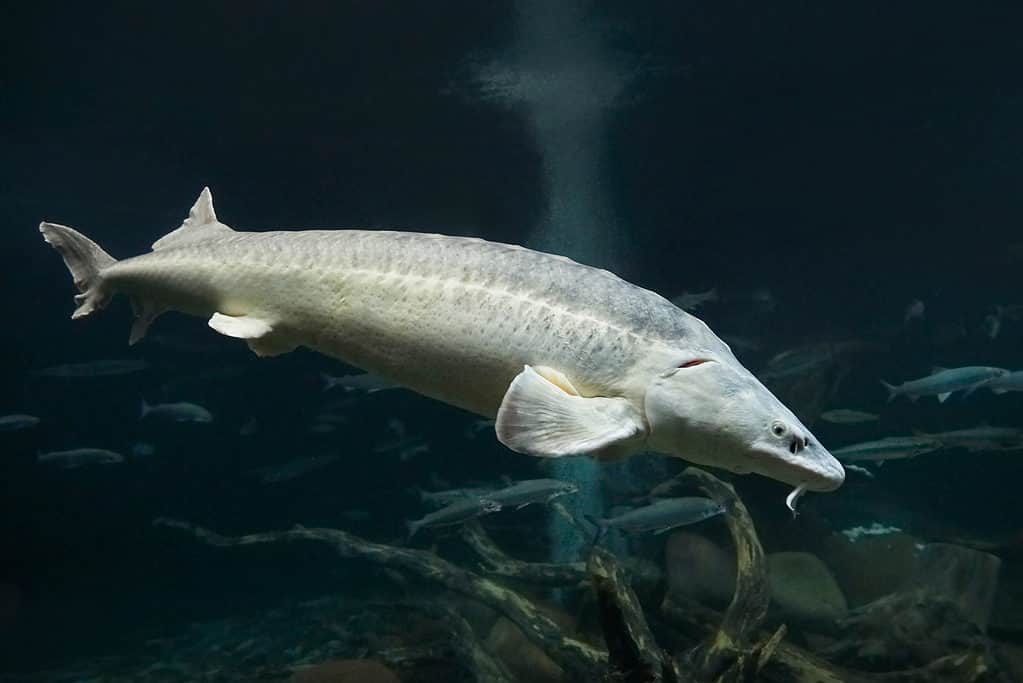
The shortnose sturgeon is a large fish that grows up to 40 inches.
©pixel creator/Shutterstock.com
Pennsylvania has only three sturgeon populations. They include the lake sturgeon, Atlantic sturgeon, and shortnose sturgeon. These fish species are similar in appearance and range and are often mistaken for each other. The shortnose sturgeon is a large fish that grows up to 40 inches. It has a short, V-shaped snout with large fleshly barbels. Although you can find it in marine and estuarine habitats in Pennsylvania, it has to swim upstream (sometimes all the way to Delaware) to spawn.
The shortnose sturgeon (along with the lake sturgeon) are endangered in Pennsylvania. Habitat loss is the major reason for the disappearance of this species. Damming of the waterways also affects the population since it makes it impossible for the sturgeon to travel upstream to their regular spawning areas. Water pollution, changes in water temperature, and getting caught accidentally by fishermen who mistake them for the Atlantic sturgeon also contribute to their decline.
Animals Living in Pennsylvania

Another large mammal that can be found in Pennsylvania is the black bear. These imposing animals are more common in the northern part of the state, where they roam through the forests and forage for food.
©Derek R. Audette/Shutterstock.com
Pennsylvania is home to a wide variety of animals, both on land and in the water.
From birds and mammals to amphibians and reptiles, the state offers a diverse range of wildlife that reflects the richness of the region’s natural environment:
- White-tailed Deer: Perhaps the most iconic animal in Pennsylvania is the white-tailed deer. These graceful creatures are found throughout the state, from the forests of the Poconos to the rolling hills of Amish country. They have often been seen grazing in meadows or darting through the woods, and they are a popular game animal for hunters.
- Black Bears: Another large mammal that can be found in Pennsylvania is the black bear. These imposing animals are more common in the northern part of the state, where they roam through the forests and forage for food. While they are generally shy and avoid humans, encounters can occur, particularly if bears are attracted to food sources like garbage cans or bird feeders.
- Eastern Box Turtle: The Eastern Box Turtle is a small, terrestrial turtle that is found in Pennsylvania’s woodlands and fields. These turtles have distinctive, domed shell that helps to protect them from predators, and they are known for their slow movements and colorful patterns. Unfortunately, the Eastern Box Turtle is listed as a species of concern in Pennsylvania due to habitat loss and other threats.
- American Bald Eagle: The American Bald Eagle is a powerful bird of prey that is often associated with American patriotism. These majestic birds can be seen soaring over Pennsylvania’s rivers and lakes, where they hunt for fish and other prey. While they were once endangered, conservation efforts have helped to increase their populations in Pennsylvania and other parts of the country.
- Brook Trout: Pennsylvania’s rivers and streams are home to a variety of fish, including the Brook Trout. This native fish is prized by anglers for its beauty and fighting spirit, and it can be found in cool, clear waters throughout the state. Unfortunately, habitat loss and pollution have threatened Brook Trout populations in some areas, making conservation efforts crucial for their survival.
Overall, the animals living in Pennsylvania reflect the state’s natural diversity and offer a glimpse into the richness of the region’s wildlife.
Wrapping it Up
There are lots of plant and animal species at risk of extinction not only in Pennsylvania but in other states as well. Human activities are major contributors to the slow decline of these animals, and interventions are necessary to save them. While legislation is in place to protect endangered animals living in Pennsylvania, more direct interventions, both on a personal and collective level, are necessary to help stabilize their population.
The photo featured at the top of this post is © pixel creator/Shutterstock.com
Sources
- PA Department of Conservation and Natural Resources, Available here: https://www.naturalheritage.state.pa.us/species.aspx
- Commonwealth of Pennsylvania, Available here: https://www.fishandboat.com/Fish/PennsylvaniaFishes/GalleryPennsylvaniaFishes/Pages/Sturgeons.aspx
- The Courier Express, Available here: https://www.thecourierexpress.com/news/local/pa-endangered-species-series-bog-turtle/article_3b705976-bfc4-5f85-bee4-46ebfb24a999.html
- Commonwealth of Pennsylvania, Available here: https://www.pgc.pa.gov/Wildlife/EndangeredandThreatened/Pages/default.aspx
Thank you for reading! Have some feedback for us? Contact the AZ Animals editorial team.






